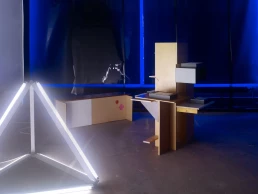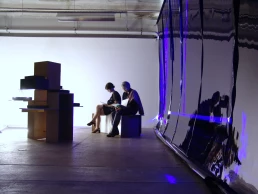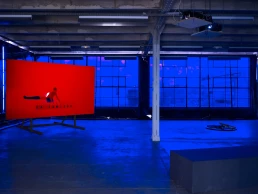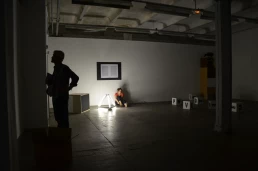(Birth of the Mikado)
SÉANCES (SESSIONS)
2012
Crédac (project associated with La Triennale 2012-Intense Proximité)
Curatrice : Claire le Restif
A show in the form of an exhibition.
An exhibition in the form a show.
Fragment and incompleteness
as the principles of a relation to the world.
A story in the form of images and sculptures.
A montage of heterogeneous elements,
assembled by the spectator.
A stage set/landscape to move through.
Séances is a narrative that takes the form of a space that is at once physical and mental, based on a practice of articulation (of forms, ideas and sensations) and on the idea of the fragment as the fundamental principle of the relation to the world. In a bluish semi-darkness, various elements without predefined meaning or organization (sculptures, films, texts, sounds, but no live actor or event) compose a stage/landscape to be moved around in, for a set time of 40 minutes. The combination of formal elements, a space, a time frame and an audience constitute this proposition as a show. The predefined, limited duration of this show, the large quantity of elements presented, their simultaneity and their specific temporalities, all ordain that the reception of these forms will be fragmented, affirming and exacerbating its heterogeneity, its incompleteness and its singularity for each spectator. The fragment is both one of the main themes and a structural element of Séances. It is a theme in that it posits and explores the notion of incompleteness as the very essence of our relation to knowledge, to the world, to other beings, to objects and phenomena. It is a motif inasmuch as each film, text or sculpture inSéances deliberately flaunts its fragmentariness. And it is a structural element because spectators cannot have access to all the elements put before them. Séances is an object with a non-predetermined meaning : it is the spectator who edits it together during the 40 minutes of the experience, using the narrative potential of certain forms just as much as the disjunctions or formal similarities. Made deliberately too short for spectators to take in all the elements they see in front of them, this duration amplifies and underscores the importance of the fragment principle and the onus placed on the spectator to choose among what is offered. Each viewer is invited to use the methods of editing, police investigation or psychoanalysis in order to constitute, whether by digression, free association or correlation, their own global form. While of course the spectator is never just a passive receiver of the forms put out by the artist, but plays an active part in constructing the meaning of a work, in Séances this active role is given exemplary form, putting the spectator’s engagement with the work on the same level as the artist’s. That said, far from being limited to this single idea, Séances is intended above all to be a plastic experience in which the affirmation of the visual power of forms is as important as the processes of their organization and reception.
This project benefited from the support of the national Fondation nationale des arts graphiques et plastiques (FNAGP), as well as from the CNAP National Center for the Visual Arts (support for the development of an artistic search).

The 40-minute film Brouillard-Enfant (Mist-Child) determines the length of Séances. An extremely slow zoom-in transforms the face of a sleeping child, filmed in nightshot, into a completely abstract grey-green video material. On the right-hand wall is the beginning of Gaëlle Obliegly’s text, which could be read in its entirety in the Bibliothèque des fragments (Library of Frgaments), and also heard through the mouth of Jean-Yves Jouannais in the film Conte de feu de camp (A Campfire Tale).

View of the room where the films Les Mots-Nuits (The Nights-Words) and Une partie d’Assemblée(A Game od Assembly) are screened. On the floor, a Feu de camp mikado (Mikado Campfire), on the wall, some texts from the Bibliothèque des fragments.

View of the screening of Une partie d’Assemblée (A Game of Assembly). In the background, a Feu de camp pyramide and the Bibliothèque des fragments
Une partie d’Assemblée (A Game of Assembly), 11’52, silent

The Library of Fragments holds a special place: it brings together an open set of texts written for the occasion by several authors (Thomas Clerc, Jean-Yves Jouannais, Eric Mangion, Gaëlle Obiégly, Élise Parré, Nathalie Quintane, Michele Robecchi, Paul Sztulman) and offered for reading only within the Séances programme. From science fiction to historical compilations and theoretical essays, this library in progress is a concert of voices that contribute to the plurality of the experience at work and enrich its understanding. At once an origin and an archive, this collection of texts maintains the ambiguity of a pre-existing history whose meaning remains to be constructed.


View of the screening of Les Mots-Nuits (The Words-Night). On the right, Feu de camp mikado
Les Mots-Nuits (The Words-Nights), 4’21, silent



View of the room where the film Naissance du Mikado (Birth of the Mikado) is screened. On the right, a Corail (Coral)

Viewers watching Naissance du Mikado (Birth of the Mikado). On the foreground, detail of a Corail (Coral) sculpture
Naissance du Mikado (Birth of the Mikado), 8’20, silent

View of the room where the film Conte de feu de camp (A Campfire Tale) is creened

View of the room where the film Conte de feu de camp (A Campfire Tale) is creened. On the walls, some texts from La bibliothèque des fragments (The Library of Fragments), on the floor, a Feu de camp pyramide (Pyramid Campfire) and some Cubes-Lettres (Letters-Cubes)
